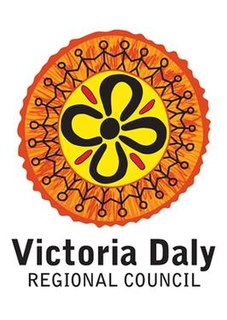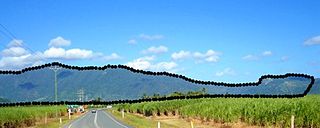History
Securing food for aboriginal nomads was always a dicey business, and the attraction of areas where Europeans settled, as places where, through kinship with indigenous people employed there, one could obtain surer supplies of food, tobacco and sugar, exercised a powerful influence on tribal shifts in Australia. Around the 1900s, taken in by Bush Telegraph rumours of marvels to be seen at a new gold mine, which had begun to operate at sv:Fletchers Gully Mine southwards in what is now the Victoria Daly Region they moved there together with the Wagiman, and never looked back to return to their homeland. According to Johannes Falkenberg, one horde of the tribe, known as the Ngargaminjin, assimilated with the Murrinh-Partha after the coming of white colonization.
Bush Telegraph was a radio program on the Australian Broadcasting Corporation's Radio National network, broadcast weekdays (Monday-Friday) at 11-12am, presenting stories from rural and regional Australia. The show ended on Friday, December 19, 2014.

The Victoria Daly Regional Council is a local government area in the Northern Territory of Australia. The shire covers an area of 153,287 square kilometres (59,184 sq mi) and had a population of approximately 2,800 at the 2016 Census.
A band society, sometimes called a camp or, in older usage, a horde, is the simplest form of human society. A band generally consists of a small kin group, no larger than an extended family or clan. The general consensus of modern anthropology sees the average number of members of a social band at the simplest level of foraging societies with generally a maximum size of 30 to 50 people.
Durmugan
The Australian anthropologist W. E. H. Stanner made the tribe famous by dedicating a paper to one particular member of the tribe, Durmugan, whom he first encountered while following a tribe he was living with, who he noticed had begun to adorn themselves in war-paint, to a full-scale battle, with over 100 warriors arranged in battle lines and hurling spears at each other. As he observed, his attention was drawn to one tall strikingly built skirmisher on the other side who displayed exemplary courage and prowess and stood out from the others. He was a Nangiomeri, who introduced himself once hostilities had ceased, and Stanner realized that he was in front of a man whom Europeans in the area called 'Smiler' with a repute for being 'the most murderous black in the region. Stanner interprets Durmugan's distinctive and powerful character in terms of an initiation he managed to undergo, despite his deracinated past, on the Victoria River, around the time of WW1. For those round Daly River the key myth of Angamunggi (the All-Father, Rainbow Serpent) had died off, as he was thought, in the midst of the rapid changes in their world, -the loss of land, disappearance of game and proliferation of deadly diseases- to have abandoned them. He was replaced by an emergent Kunapipi cult, an All-Mother represented by the bull-roarer Karwadi, which had been adopted from the earlier belief system. It was the stimulus of this new native messianic cult that, in Stanner's view, fired men like Durmugan to lead the lives they did.
Stanner's long memoir of Durmugan soon became famous, with its insightful tale of the relationship between a native informant and his anthropologist interpreter. Robert Manne has called it 'the finest essay by an Australian' he had ever come across.
His name indicated a Murrinh-Patha connection, being a variant on a place-name, Dirmugam, in the latter Nangor clan's territory. His only equal, and, in dance, superior was a Murrinh-Patha warrior and trickster called Tjimari, whose story was given lustre after he madew friends with the Australian poet Roland Robinson.
This page is based on this
Wikipedia article Text is available under the
CC BY-SA 4.0 license; additional terms may apply.
Images, videos and audio are available under their respective licenses.

Australian Aboriginal religion and mythology are the stories traditionally performed by Aboriginal peoples within each of the language groups across Australia.
Nganʼgityemerri—or Nganʼgi for short—is an indigenous language spoken in the Daly River region of Australiaʼs Northern Territory. The language is spoken in three mutually intelligible dialects: Nganʼgikurunggurr, Ngenʼgiwumirri, and Nganʼgimerri, which are 90% cognate but distinct languages sociolinguistically. Nganʼgi is spoken by about 150-200 people in the region around the Daly River and in a number of smaller outstations on traditional lands. Official census data, however, states only 26 at home speakers.
Murrinh-patha, called Garama by the Jaminjung, is an Australian Aboriginal language spoken by over 2,500 people, most of whom live in Wadeye in the Northern Territory, where it is the dominant language of the community. It is spoken by the Murrinh-Patha people, as well as several other peoples whose languages are extinct or nearly so, including the Mati Ke and Marri-Djabin.
The Mati Ke otherwise known as the Magatige, are an indigenous Australian people, whose traditional lands are located in the Wadeye area in the Northern Territory, Their language is in danger of extinction.
The Madngella, otherwise known as the Matngala or Hermit Hill tribe, are an indigenous Australian people of the Northern Territory, Australia.
The Marranunggu are an indigenous Australian people, and language group, of the Northern Territory.
The Maridan were an indigenous Australian people of the Northern Territory.
The Maridjabin or Marrisjabin, were an indigenous Australian people of the Northern Territory.
The Emmiyangal, also known as the Amijangal, are an indigenous Australian people of the Northern Territory in Australia,
The Wadjiginy, also referred to historically as the Wogait, are an indigenous Australian people of the Northern Territory.
The Kungarakan (Koongurrukuñ) were an indigenous Australian people of the Northern Territory.
The Djerait were an indigenous Australian people of the Northern Territory
The Pongaponga were an indigenous Australian people of the Northern Territory. They may have been a band of the Ngolokwangga.
The Ngolokwangga are an indigenous Australian people of the Northern Territory.
The Yunggor were an indigenous Australian people of the Northern Territory
The Muringura, or Murrinh-Kura, were an indigenous Australian people of the Northern Territory.
The Wagoman were an indigenous Australian people of the Northern Territory.







